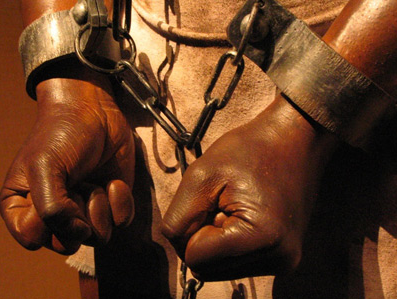The life of Crispus Attucks cannot be fully substantiated as records of slaves during the colony were poorly documented. There are no records of his life after he escaped his master until his death in 1770.
It is believed that Attucks was born a slave in Framingham, Massachusetts in 1723. Both his parents were slaves owned by Colonel Buckminster from Framingham, Massachusetts. Documents describe Crispus as a man of mixed parentage; his father, Prince, was an African slave and his mother, Nancy, was a Wampanoag or Natick Indian forced into slavery. Crispus Attucks was named after the word “attucks” that comes from the native Wampanoag language and means small, male deer.
Attucks might have had an older sister and a younger brother who died as a child. He lived with his parents serving Colonel Buckminster until he was 16 when he was sold to Deacon William Brown who also resided in Framingham. Attucks work for Brown consisted in trading cattle. When he was about 27 years old he escaped seeking freedom.
Regarding his escape, three notices were published in the Boston Gazette and Country Journal. The first notice appeared on Tuesday, October 2, 1750 offering a 10 pound reward for the return of a run-away slave named “Crispas”.
“Ran-away from his Master William Browne of Framingham, on the 30th of September, last, a Mulatto Fellow, about 27 years of age, named Crispas, six feet, two inches high, short curl’s Hair, his Knees nearer together than common; had on a light colour’d Bearskin Coat, plain brown Fustian Jacket, or brown all-Wool one, new Buckskin Breeches, blue Yarn Stockings, and a checked woolen Shirt.
Whoever shall take up said Run-away, and convey him to abovesaid Master, shall have ten pounds, old Tenor Reward, and all the necessary Charges paid. And all Masters of Vessels and others, are herby cautioned against concealing or carrying off said Servant on Penalty of the Law. Boston, October 2, 1750.”
A second and a third notice dated November 13 and November 20, 1750 appeared in the Boston Gazette and Country Journal also offering a detailed description of Attucks and a reward for his return. In the eighteenth century the standards for spelling were more relaxed than today. Historians assume that Crispas and Crispus are the same name.
Attucks was tall, 6 feet and 2 inches; he was physically strong and agile, fitting the desirable characteristics of a whaler. He used the name Michael Johnson as an alias and had no trouble finding occupation in a whaling ship. Being a whaler was a physically demanding and dangerous job. He would row a small boat, harpoon the whale and transport it to the ship. Whaler ships were about six weeks on the sea before they returned to land. It is believed that Crispus left his whaler job sometime during the French Indian War between 1754 and 1760 to become a merchant seaman. He never raised suspicion as ran-away slave as his employers considered him Indian. Between sailings he would work as a rope maker in Boston Harbor.
Attucks had the capabilities of a leader and on the night of March 5, 1770 he led a group of sailors, who either stood up for what they believed or were just troublemakers. He was the first to die in the event known as the Boston Massacre. Read more about the role of Crispus Attucks in the Boston Massacre.
Attucks and the other victims of the Massacre were buried like heroes in the Granary Burial Ground in Boston, thousands followed their funeral. Buried in this cemetery are many notable citizens such as three of the signers of the Declaration of Independence, John Hancock, Samuel Adams and Robert Treat Paine and patriots Paul Revere and James Otis, among other notable citizens.
The following is a transcription of the Inquisition of Michael Johnson’s death that took place one day after his death on March 6th, 1770. Note the coroner’s jury referring to Michael Johnson and not Crispus Attucks.
SUFFOLK,ss. An Inquisition Indented, taken at Boson within the said County of Suffolk the Sixth Day of March in the tenth Year of the Reign of our Sovereign Lord, George the third by the Grace of God, of Great-Britain, France and Ireland, King, Defender of the Faith, & c. Before Robert Pierpont gent” one of the coroners of our said Lord the King, within the County of Suffolk aforesaid; upon the View of the Body of Michael Johnson then and there being Dead, by the Oaths of Benjamin Waldo Foreman, Jacob Emmon, John McLane, William Fleet, John Wise, John How, Nathaniel Hurd, William Baker junior, William Flagg, William Crafts, Enoch Rust, Robert Duncan, William Palfrey & Samuel Danforth, good and lawful Men of Boston aforesaid, within the County aforesaid; who being Charged and Sworn at enquire for our said Lord the King, When and by what Means, and how the said Michael Johnson came to his Death: Upon their Oaths do say that the said Michael Johnson was willfully and feloniously murdered at King Street in Boston in the County aforesaid, on the Evening of the 5th instant, between the hours of nine & ten by the discharge of a Musket or Muskets leaded with Bullets, two of which were shot thro’ his body, by a party of Soldiers to us unknown, then and there headed and commanded by Captain Thomas Presto of his Majesty’s 29th Regiment of foot, against the peace of our Sovereign Lord the King his Crown and dignity, and so by that means he came by his death as appears by evidence.
In witness whereof, as well I the Coroner aforesaid, as the Jurors aforesaid, to this Inquisition have interchangeably put our Hands and Seals, the Day and year aforesaid.
Source: The New England Historical and Genealogical Register, pg.382, Volume 44, Henry Fitz-Gilbert Waters, New England Historic Genealogical Society.
Over the next few days media refereed to the dead mulatto as Crispus Attucks.
